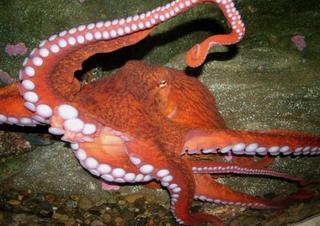Octopus Poses Problems for Pot Cod Boats and Researchers

Tuesday, November 15 2011
So far this year, only one group of boats has been prohibited from fishing in the Bering Sea because of bycatch problems. It’s not because this group took too much salmon, or halibut, or seabirds, or anything else that typically gets people riled up. Instead, boats catching Pacific cod using pots were ordered to stop all activity in late October because they brought up too many octopuses -- about a million pounds of them this year to date. KUCB’s Alexandra Gutierrez was at the groundfish plan team meeting in Seattle this week, where scientists discussed ways to keep this from happening again.
The octopus doesn’t have many advocates outside of small children and maybe obsessive World Cup fans who still remember Paul the Octopus fondly. The species in Alaska waters aren't endangered, and there aren’t any boats that specifically target it here. If it’s sold at all, it’s usually sold as bait. According to National Marine Fisheries Service observer reports, pot cod boats almost always bring up octopus alive and fighting, and they can throw them back into the water since they don’t have swim bladders and aren’t affected by depth changes.
So why did six boats see their season cut short? They were affected by a recent regulatory change, one that management biologists set out to revise yesterday while meeting at the Alaska Fisheries Science Center in Seattle.
Starting this year, octopus bycatch was counted separately from other species, and the amount allowed to be taken was based on historical levels. According to NMFS scientist Liz Conners, that didn’t work out perfectly.
“Just our luck that the first year we have a separate total allowable catch for octopus, we catch more octopus than we ever have before,” said Conners.
The overfishing level for octopus is hard to set. The animals aren’t usually caught in the NMFS trawl survey, and there isn’t solid data on how many actually survive after they’ve been thrown overboard. Some researchers like Unalaska Marine Advisory Program Agent Reid Brewer have tried to find ways to tag octopus, even using things like silicon tattoos, but there aren’t any current population estimates from these studies that management biologists can use this year.
So now, scientists have tried to estimate the amount of octopus in the Bering Sea by looking at how much octopus cod are eating -- something they’re calling the “food web estimate.” It gives a better picture of what’s going on with the octopus stock, even if scientists acknowledge that it doesn’t provide a totally clear one.
“There’s a lot of uncertainty in the trawl survey estimate. There’s uncertainty in the the adjustment we’ve got over the mortality rate. There’s uncertainty in the food web estimate,” said Conners.
Even so, the consensus at the groundfish plan team meeting was that the food web estimate was a better figure to use than the historical catch rate or the trawl survey estimate. If regulators go with that number, the overfishing level could rise up to about seven million pounds.
Members of the fishing industry are likely to agree with that approach. Kenny Down is the executive director of the Freezer Longline Coalition, and he was at the meeting yesterday. Even though the catcher processors he represents weren’t affected by the closure, he criticized the current regulation for being conservative to the point of causing waste in the fishery.
“It really forced a great deal of regulatory discard. It forced waste in the fishery where people were catching octopus that they may have retained, but were forced to throw over the side,” said Down. “It was kind of a double whammy. Not only did it close the pot fishery and leave a lot of cod that’s now going to go uncaught, but this previous methodology forced people like our boats to throw octopus over the side when they may have kept some small amounts.”
The North Pacific Fishery Management Council will consider the plan team’s recommendation when they meet in Anchorage in December.



